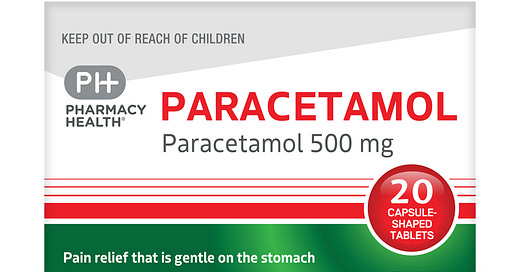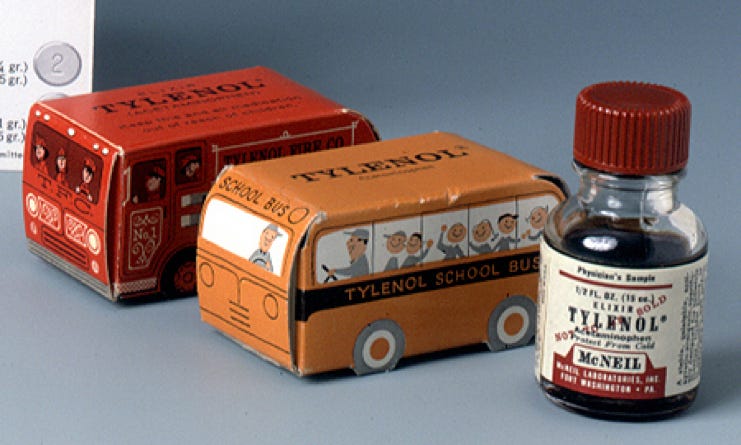Listen to this article:
Consider the humble white pill. Perhaps it sits in your purse, your desk drawer, your bathroom cabinet. In America, you call it Tylenol. Here in Australia, or in the UK, it's paracetamol, maybe under the brand name Panadol. It’s the go-to remedy for a headache, a fever, the aches that follow a long day. Ubiquitous. Ordinary, even. We pop billions of these pills every year – over 25 billion doses in the US alone, maybe more. It’s woven into the very fabric of modern discomfort management.
But what if this familiar friend has a hidden life? What if the story we tell ourselves about this simple pain reliever is… incomplete?
Let's start with a curious quirk involving its name. Acetaminophen here, paracetamol there. Tylenol, Panadol. Why the multiple identities for the exact same chemical – good old N-acetyl-para-aminophenol? It’s a small detail, a linguistic fork in the road reflecting different national drug naming conventions, but it hints at a more complex character beneath the surface.
Now, think about safety. We regard acetaminophen as gentle, right? Safer than aspirin for kids, easier on the stomach than ibuprofen. And used correctly, it is. But there’s a catch, and it’s a sharp one. The line between a helpful dose and a liver-destroying one is surprisingly thin – what pharmacologists call a narrow therapeutic index. For an adult, the safe upper limit is generally considered around 4,000 milligrams a day – that's just eight extra-strength tablets. Go much beyond that, especially in a short period, and you're venturing into dangerous territory.
It’s what toxicologists call a dose-dependent toxin. Take too much, and the liver's natural detoxification system, its internal cleanup crew relying on a substance called glutathione, gets swamped. A harmful byproduct, N-acetyl-p-benzoquinone imine (or NAPQI for short), which is normally neutralized quickly, starts to build up, accumulating and wreaking havoc on vital liver cells. Cross that line, and you risk acute liver failure.
Often, it's not a deliberate act, but an accidental miscalculation – taking one product for a headache, another multi-symptom remedy for a cold, without realizing both contain acetaminophen, unknowingly pushing the total daily dose over that critical threshold. In fact, this kind of overdose, frequently unintentional, stands as a leading cause of acute liver failure in the United States and other Western nations, responsible for countless hospital visits and tragic deaths each year. It's a stark reminder of the power contained within such an ordinary-seeming pill.
Sure, other common painkillers have their demons. Too much ibuprofen can assault your kidneys or stomach lining. Aspirin carries risks of bleeding and the terrifying, though now rare, Reye’s syndrome in children. None are perfectly benign when misused. Yet, acetaminophen’s particular talent for overwhelming the liver, sometimes at doses not dramatically higher than the daily maximum, gives its toxicity a unique and sobering profile. It's not alone in being a popular drug with a dangerous edge – ibuprofen and aspirin share that stage, consumed in the tens of billions of doses annually themselves – but its specific danger is stark.
So, we have this incredibly common pill, with its quirks and hidden dangers. But here’s another twist in the tale, one that cuts to the very reason we reach for it; how well does it actually do the job we take it for? We assume it works, broadly speaking. But the scientific evidence paints a much patchier, more surprising picture.
Take low back pain, one of the most common reasons people seek pain relief. For decades, guidelines often suggested paracetamol as a first step. Yet, rigorous, high-quality reviews, looking at numerous studies, have come to a startling conclusion. For acute low back pain, paracetamol is likely no better than a placebo. It turns out, for that aching back that sends millions to the pharmacy, this ubiquitous pill might be doing almost nothing at all beyond the power of suggestion. This finding directly challenges long-held medical wisdom, forcing a rethink of how we treat this pervasive ailment.
What about osteoarthritis, the wear-and-tear joint pain that affects so many, especially as we age? Here, the story is different, but still nuanced. Studies show paracetamol can reduce pain and disability compared to a placebo. But look closer, and the benefit is often described as statistically significant, yet clinically minimal. It helps, yes, but perhaps barely enough for many patients to feel a meaningful difference in their daily lives. And when compared directly to NSAIDs like ibuprofen, paracetamol often comes up short in effectiveness. Why is it still recommended as a first-line treatment then? Largely because of its perceived better safety profile compared to the stomach and kidney risks of NSAIDs – though even that assumption is being questioned with concerns about long-term paracetamol use.
It's not that it never works. There's decent evidence it can help with tension headaches. It’s also a valuable player in managing pain after surgery, often used intravenously or as part of a multi-drug approach to reduce the need for opioids. And for general mild-to-moderate aches and pains – a toothache, muscle soreness, the discomfort of a cold – it seems to provide relief for many. Faster-acting formulations like effervescent tablets might bring relief quicker, while extended-release versions aim for longer duration.
But the overall picture isn't one of reliable, potent relief across the board. Instead, the reality is a mosaic of effectiveness—surprisingly useless for some common conditions, modestly helpful for others, and reasonably effective for a few. The reality of acetaminophen's efficacy is far more complex and, frankly, sometimes disappointing than its ubiquitous presence on our shelves might suggest.
And the story takes an even stranger turn from there. What if this painkiller does more than just dull physical aches (sometimes)? What if it touches something deeper – our very ability to connect with others?
In 2010, a researcher named C. Nathan DeWall and his colleagues did something intriguing. They wondered; could acetaminophen soothe the sting of social rejection, the kind of hurt feelings we get from being left out? They gave students either acetaminophen (1,000mg a day) or a placebo for three weeks. What were the results? Those taking the painkiller reported fewer hurt feelings from social slights. Later, they put people in an fMRI scanner and had them play a virtual ball-tossing game designed to make them feel excluded. The brains of those who had taken acetaminophen showed less activity in the regions typically associated with processing this kind of social pain – the dorsal anterior cingulate cortex and the anterior insula. It was as if the drug was blurring the lines between physical and social hurt.
Okay, that’s interesting. It dulls the pain of rejection. But then, in 2016, Dominik Mischkowski asked a different question, wondering about positive feelings. What happens to our ability to feel happy for others – what psychologists call positive empathy – when we take this pill? He gave participants acetaminophen or a placebo and had them read scenarios about other people experiencing good things. The finding was startling, revealing that acetaminophen didn't just blunt social pain; it also reduced the participants' own feelings of pleasure and empathy towards the positive experiences of others. They could still recognise that something good was happening to someone else, but they didn't feel it as strongly themselves.
This finding – that a common pill can dial down our ability to emotionally connect with others' joy – is startling enough. But it also opens a strange window onto conditions often defined by a chronic lack of empathy, such as psychopathy or narcissism. It's not that the pill creates these conditions, of course. Rather, it offers a fleeting, chemically induced glimpse into what it might feel like, neurologically, when the circuits of fellow-feeling are dampened. It's almost like a temporary echo of that state, induced by something found in nearly every medicine cabinet. It underscores how fundamental, and perhaps how biochemically fragile, our capacity for empathy truly is.
How could this be? The researchers speculate – and a study on rats seems to back this up – that acetaminophen might be subtly tweaking our brain chemistry, perhaps interfering with hormones like oxytocin and vasopressin, key players in social bonding and empathy. The human studies didn't directly measure these hormones, but they did show changes in brain regions crucial for emotional processing. It’s like a volume knob for fellow-feeling being turned down, dose by dose.
Now, consider the scale. In Australia, more than 60% of adults buy paracetamol at least once a month. In the US, around a quarter of adults – perhaps 50 or 60 million people – use an acetaminophen-containing product every single week. The average American might consume around 300 doses a year. If this incredibly widespread drug, with its surprisingly variable effectiveness for physical pain, is also dampening empathy, even slightly, what does that mean when multiplied across millions of people, day after day?
This brings us to a potentially profound, if speculative, connection. Around the same time DeWall was publishing his findings on social pain, another researcher, Sara Konrath at the University of Michigan, released a stunning meta-analysis. Looking at empathy scores of American college students from 1979 to 2009, she found a dramatic drop – 40 percent! – particularly in measures of empathic concern and perspective-taking. The decline, she noted, seemed to accelerate after the year 2000. Konrath initially pointed towards factors like the rise of social media.
But think about the timeline. When did acetaminophen become the dominant force in the American painkiller market? Its journey was slow and almost didn't happen at all. It was first synthesized way back in 1878 by H. N. Morse at Johns Hopkins University. Its pain and fever-reducing properties were noted clinically, perhaps first by Joseph von Mering in 1893. But the crucial point is that the late 19th century was a gold rush for synthetic drugs. Acetanilide (marketed as Antifebrin) had been discovered accidentally in 1886 and became an instant hit. Phenacetin followed quickly in 1887. Both were chemically related to paracetamol, and they stole the limelight.
Paracetamol, the quiet cousin, was largely ignored. Adding to its woes was a cloud of suspicion. Early research on those related drugs, phenacetin and acetanilide, revealed they could cause a nasty side effect known as methemoglobinemia, a condition where the blood can't carry oxygen properly. This concern, likely by association, shadowed paracetamol. Although we now know that methemoglobinemia from paracetamol itself is rare, usually occurring only in massive overdoses or in people with specific conditions like G6PD deficiency, the initial fear, coupled with the success of its competitors, kept paracetamol off the market for decades. It was a drug discovered, briefly noted, and then effectively forgotten.
It took until 1949 for its resurrection. Researchers, particularly the famed pharmacologist Bernard Brodie and his colleague Julius Axelrod (who would later win a Nobel Prize, partly for this work), were investigating why those older drugs like acetanilide and phenacetin worked – and why they were sometimes toxic. They discovered something crucial. The body actually breaks down both acetanilide and phenacetin into paracetamol. It turned out paracetamol was the real active ingredient doing the heavy lifting for pain and fever relief, without the major toxicity baggage (especially kidney damage) linked to its parent compounds, particularly phenacetin. This rediscovery was the key. It revealed paracetamol not just as a chemical curiosity, but as the safer, effective metabolite the world had overlooked.
This gave it a second chance. McNeil Laboratories saw the potential, particularly for children, and launched Children’s Tylenol in the US in 1955. Frederick Stearns & Co. introduced Panadol, prescription-only initially, in the UK in 1956, the same year Australia got Paracetamol. Around 1960, it shed its prescription status in these countries. It gained traction, seen as safer than aspirin, especially for ulcers and kids.
But the real turning point, the event that truly catapulted acetaminophen from a contender to the champion, particularly in the US, arrived with a chilling medical mystery in the early 1980s. Before this, aspirin had reigned supreme for much of the 20th century. It was the original wonder drug, the automatic choice for aches, pains, and fevers, a medicine cabinet staple found in nearly every home. Its brand name was synonymous with relief.
Then, in the late 70s and early 80s, a shadow fell. Whispers grew into alarming reports from doctors and researchers, culminating in studies that pointed a finger directly at aspirin. They linked its use during viral illnesses like the flu or chickenpox, primarily in children and teenagers, to a rare but devastating condition called Reye's Syndrome. This wasn't just a side effect; it was a potential catastrophe, causing sudden, severe swelling of the brain and liver damage, often leading to death or permanent neurological injury.
The connection, once established, triggered a public health earthquake. The US Surgeon General, the Centers for Disease Control, and other health authorities issued urgent warnings telling parents not to give aspirin to children or teenagers with flu or chickenpox symptoms. Warning labels became mandatory on aspirin bottles. The message was clear and terrifying for parents. Aspirin's pediatric stronghold, built over generations, crumbled almost overnight.
And into that sudden, fear-induced vacuum stepped acetaminophen. Tylenol, already marketed as gentle and safe for children, became the obvious, trusted alternative. The shift was dramatic and swift. And the fear, though centered on children, cast a long shadow. Trust in aspirin wavered, even among adults who weren't directly at risk of Reye's. Acetaminophen's rise wasn't just in the nursery; it was across the board, fueled by the sudden downfall of the long-reigning king. By the late 2000s, as Konrath was documenting plummeting empathy scores, Americans were buying over 25 billion doses a year.
Correlation, of course, is not causation. Konrath didn't study Tylenol use. Many factors shape societal empathy. Yet, the parallel is striking; as the consumption of a drug now known to subtly dampen empathy (and whose physical pain relief is more limited than widely assumed) soared, measured empathy levels fell.
Could it be? Could the very pill we reach for to soothe our aches – a pill that might not even be working that well for some of our most common pains – be inadvertently contributing to a broader emotional numbing, a silent shift in our collective capacity for connection? It’s a provocative thought, born from connecting the dots between pharmacology, psychology, efficacy data, and social trends.
The story of acetaminophen is far richer and stranger than we might assume, looking at that simple white pill. It’s a tale of mistaken identity, hidden dangers, variable effectiveness, market shifts driven by fear, and, most unsettlingly, a potential, subtle influence on the very emotions that bind us together. The pill we thought we knew might be reshaping us in ways we're only beginning to understand.








Is the empathy-dampening effect reversed when stopping taking paracetamol?
I felt that Reynes syndrome was a tad too convenient after a century of aspirin use.